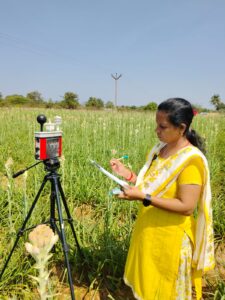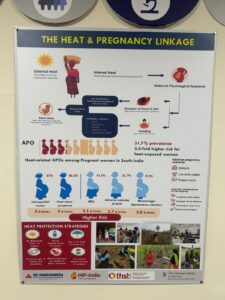A study initially analysing heat’s impact on workers found women, particularly in India’s informal workforce, were more affected. This led to research on extreme heat’s effects on pregnant women, revealing a lack of prior studies
Published Mar 27, 2025 | 7:00 AM ⚊ Updated Mar 27, 2025 | 2:34 PM

Pregnant women exposed to extreme heat are at risk of losing their babies
Synopsis: Dr Vidya Venugopal, from Sri Ramachandra Institute, shared her team’s ongoing heat-related studies since 2012. Initially analysing heat’s impact on workers in extreme conditions, they discovered women, especially in India’s informal workforce, were more affected. This led to a study on the impact of extreme heat on pregnant women, revealing a surprising lack of prior research on the subject.
On a scorching afternoon in 2018, 21-year-old Maheshwari, a pregnant woman, was harvesting sugarcane in the fields. She experienced discomforting pain in her abdomen but dismissed it as a normal occurrence and continued her work. After completing her tasks for the day, she visited the nearby hospital for a check-up, only to receive heartbreaking news—the doctors informed her that her baby no longer had a heartbeat. Left with no other choice, she had to undergo an abortion.
Dr Rekha Shanmugam first met Maheshwari at a primary healthcare centre in Thittakudi. At that time, Dr Rekha was pursuing her PhD at Sri Ramachandra Institute of Higher Education and Research, focusing on the effects of extreme heat on pregnant women.
Maheshwari, who was in her first trimester of pregnancy, worked as a sugarcane harvester due to her family’s financial situation. Her daily routine involved leaving home at 7 am and working in the scorching heat until 1 pm.
Despite Dr Rekha’s advice to rest and avoid working under extreme heat, Maheshwari explained that she had no other option due to her circumstances. However, Dr Rekha continued to monitor her temperature, weight, and diet regularly.
By the time Maheshwari entered her second trimester, Dr Rekha learned the devastating news of her miscarriage. Analysing the data she had collected—Maheshwari’s previous body temperature, weight, diet, and temperature at the time of foetal demise—Dr Rekha compared these findings with data from other pregnant women she had been tracking. This analysis revealed that extreme heat exposure had played a crucial role in Maheshwari’s miscarriage.
A year later, in 2019, Dr Rekha travelled to Tiruvannamalai for another field study. There, she met 23-year-old Devi, who, like Maheshwari, was in her first trimester. Due to her family’s financial constraints, Devi had no choice but to continue working despite her pregnancy.
Dr Rekha immediately began monitoring Devi’s health, tracking her core body temperature, urine specific gravity, pre-, present, and post-shift temperatures, dietary intake, and medication usage. This monitoring continued through her second and third trimesters. Despite her pregnancy, Devi worked in a brick kiln until the day she gave birth.
Unexpectedly, Devi went into labour and delivered her baby. Unfortunately, she had a preterm birth, and the baby was underweight. Upon reviewing Devi’s test results from each trimester, Dr Rekha discovered a consistent rise in Devi’s body temperature. This led her to conclude that excessive heat exposure had significantly contributed to both Devi’s premature delivery and the baby’s low birth weight.
To gain deeper insights into this study, South First met with Dr Rekha and her PhD supervisor, Dr Vidhya Venugopal, a professor at Sri Ramachandra Institute of Higher Education and Research. They were busy preparing for their next field study.

Dr Rekha, on-field
Dr Vidhya shared that she and her team of PhD researchers and students had been conducting heat-related studies since 2012. “In 2012, we initiated a research project to analyse the impact of extreme heat on people. We conducted field studies in various locations, including brick kilns, salt pans, and factories. Our objective was to compare individuals who worked in direct heat exposure with those who worked indoors. We discovered that many people suffered from excessive heat stress and dehydration,” she explained.
“Moreover, we found that women were more affected than men. This is because, in India’s informal workforce, women outnumber men, especially in jobs that require direct exposure to sunlight. This realisation led us to a crucial question—if women are so severely affected, what impact does extreme heat have on pregnant women? That question was the foundation of this study,” she said.
“We conducted an extensive literature review to determine if any prior research had been done on this subject. Surprisingly, we found none. Since India is a hot country, extreme heat is considered normal and an inseparable part of daily life. As a result, very little research has been conducted on its health impacts. The complete lack of information on how heat affects pregnant women shocked us. So, we took this as a challenge and began our study,” she added.
Dr Vidhya then introduced Dr Rekha, who led the research.
Dr Rekha explained that their research was an epidemiological study.
“We closely monitored pregnant women, tracking their body temperature and other health factors while continuously interviewing them. We then analysed the collected data to derive conclusions,” she explained.
For this study, Dr Rekha examined women working in over 15 different occupations, including agriculture fields such as sugarcane harvesting, paddy farming and brick kilns, garment factories, schools, and banks—comparing those working in high-heat environments with those in lower-heat environments.
From 2018 to 2022, she studied 800 pregnant women across eight districts in Tamil Nadu, including Thiruvallur, Kanchipuram, Thiruvannamalai, Cuddalore, Nagapattinam, and Trichy.
Throughout all three trimesters, they monitored several health parameters such as core body temperature, urine specific gravity, pre- and post-shift temperatures, dietary intake, and medication usage.
By comparing the collected data, they discovered that pregnant women working in extreme heat conditions had double the risk of miscarriage compared to those working in cooler environments.
The study revealed that pregnant women suffer from heat exposure in two ways.
The heat generated within the body due to strenuous work redirects blood flow towards the skin to cool the body down. However, this reduces the blood supply to the foetus, which can negatively impact foetal health.
Women working in agriculture and construction often wear sarees with a shirt or blouse on top. This type of clothing increases heat retention, making them more vulnerable to heat stress, Dr Rekha noted.
Key Findings

The link between pregnancy and heat
Out of the 800 pregnant women in the study:
The study found that pregnant women exposed to heat were at significantly higher risk compared to those who were not:
The study highlighted several negative pregnancy outcomes, including:
Additionally, long-term consequences for the offspring included:
Currently, with funding from Oxford University, this research team is conducting an expanded study in collaboration with multiple stakeholders. This new study aims to track pregnant women from conception until 14 days after childbirth, analysing all physiological changes, health conditions, temperature variations, and nutritional factors. A comprehensive report will be submitted at the end of the study.
When discussing how to tackle or mitigate this challenge for pregnant women, Dr Vidhya expressed a stark reality: “No matter what you do, nothing can be changed for the next 50 years.”
She explained, “The environmental damage we have already caused will have lasting effects for at least 50 years. Even if we stop all vehicle emissions and carbon pollution today, the impact will persist. Therefore, completely preventing these effects is impossible.”
However, she emphasised that adopting appropriate lifestyle changes and policy-level interventions could help mitigate the damage.
For instance, many of these pregnant women have no choice but to work due to financial constraints. To address this, she suggested the creation of an insurance system that provides daily wages to women who take leave during the hottest periods of pregnancy.
Additionally, Dr Vidhya mentioned that her team is developing a new resource material to help identify and manage heat-related health risks for pregnant women. This material will be provided to primary healthcare centres and shared with the government unconditionally to ensure better maternal care.
At the policy level, governments that are increasingly focusing on climate change must also prioritise vulnerable groups such as pregnant women. Implementing protective policies for them is critical.
Dr Vidhya further emphasised that while government policies play a crucial role, individual and community participation is equally important.
Dietary habits, for example, play a major role in helping the body regulate heat stress. Both Dr Vidhya and Dr Rekha emphasised that:
To spread awareness, Dr Rekha has been actively working at the grassroots level, travelling across multiple districts and engaging with Local village leaders, Primary healthcare centres, Community organisations and social movements.
Through these initiatives, she is educating communities on how to protect pregnant women from extreme heat and advocating for better maternal health policies.
(Edited by Ananya Rao)
